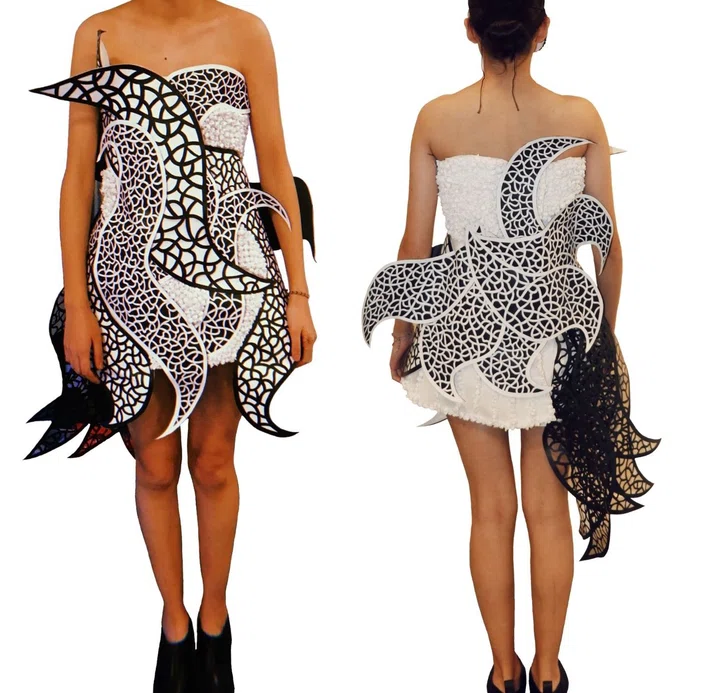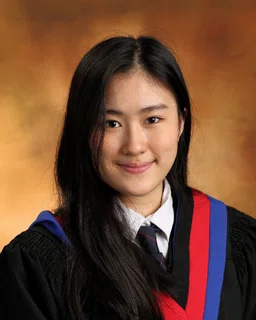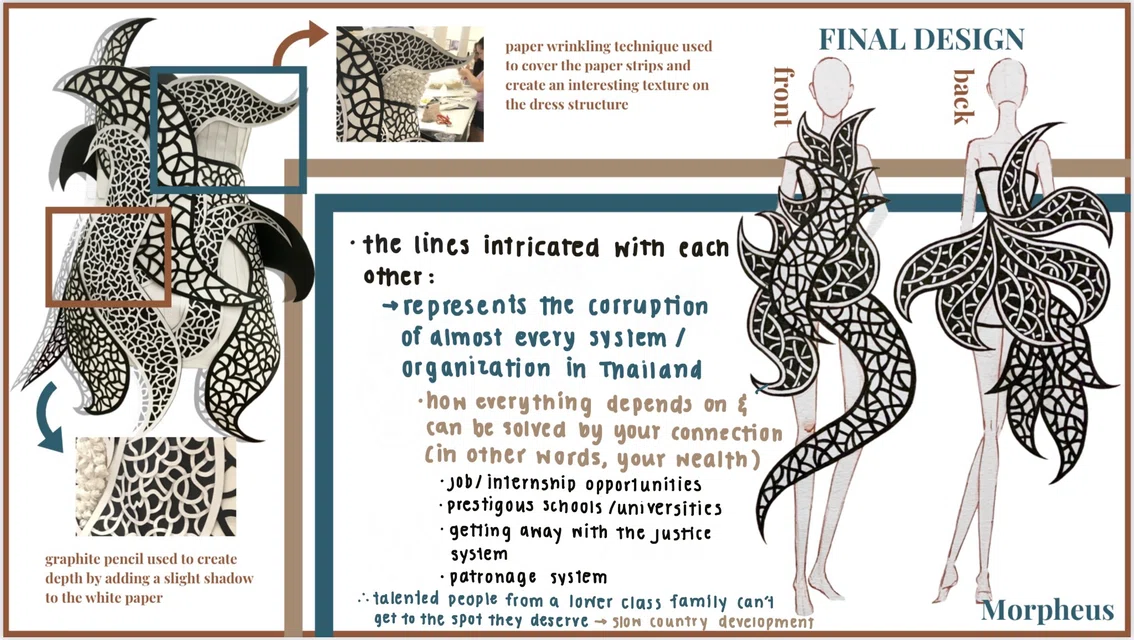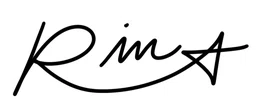




Rinradee Audsabumrungrat
ST MICHAELS UNIVERSITY SCHOOL|Victoria BC, Canada
TEACHER: Brad Ingimundson
3-D Art and Design

Morpheus|24 x 12 x 10 in.
Ideas: The pavilion imitates being under trees, emphasizing verticality in nature/architecture.
Material(s): paper, duct tape, pencil
Process(es): In Morpheus created paper dress structure then used paper cutting and wrinkling to make ornaments

I decided to work with the theme of exploring different social, environmental, and political issues in my homeland through wearable art, fashion, accessories, flights of fancy, and whimsy.
Student statement
Student
statement

Rinradee Audsabumrungrat
Through this fashion garment, Morpheus, I want to illustrate how everything in Thailand depends on and can be easily solved by one’s connection, or in other words, one’s social status and wealth.
Moving into a boarding school in Canada in grade nine, I’ve learned to not only appreciate all the little things Thailand has offered me for over ten years but also to see many problems with the traditional Thai systems I once was ignorant of. My beautiful Thailand is complex and like all things, there are things I love and things I wish were different. Fashion is the media that allows me to speak out and inspire change. Hence, in my AP 3D Art portfolio, I decided to work with the theme of exploring different social, environmental, and political issues in my homeland through wearable art, fashion, accessories, flights of fancy, and whimsy.
Through this fashion garment, Morpheus, I want to illustrate how everything in Thailand depends on and can be easily solved by one’s connection, or in other words, one’s social status and wealth. Morpheus is made entirely of paper and duck tapes, and the main techniques used are paper cutting and paper wrinkling. The paper pieces are cut out by hand and layered on top of the opposite-color papers to create a pattern of integrated linework. I also used a graphite pencil to create depth by adding a slight shadow to the white paper to make it appear as if the lines are overlapping one another. Paper wrinkling technique is utilized as well to cover the empty areas of the dress structure and create interesting textures.
The lines integrated with each other represent the corruption found in almost all of the Thai systems/organizations. These range from the internship opportunities, essential to get into prestigious universities, that are mostly only available to the kids of the company’s high-ranked managers to the common cases of affluent people getting away with the justice system through connection and under-the-table payments. As unfair as it may seem, this problem has continually been normalized, because of the education system that discourages the young ones to question or criticize the country and its traditions, but instead encourages them to conform to the social norms. Thus, this corrupted cycle continues on, leaving talented ones from lower-class families struggling to make it to the spot they deserve and highlighting the prominent issue of wealth inequality in Thailand.
Teacher
statement
Brad Ingimundson
Rin possesses that wonderful combination of natural ability and desire to improve her technical understanding and push boundaries, and a genuine curiosity that filters the world around her for inspiration. Like many teachers, I see my role as lighting a series of fires, and I encourage my students to follow their own interests. Rin understood this early and seized every opportunity to expand her range of experiences and, as we would expect (or hope in some cases), this synergistically takes hold and transcends into a prolific outpouring of creativity. This is part maturity and part how she is wired. Rin is thoughtful and deliberate in her art-making and she craves deeper understanding. Her writing acts as a processing mechanism that she employs to work through her creative impulses and helps hone and clarify her final output. This way, she is able to tap into her playful, whimsical, and experimental side and temper it with the sophistication that comes from deeper understanding, machination, and reflection. In many ways, the AP Art and Design course, with its high expectation of student independence met Rin’s maturity and ability to step into that responsibility at just the right time. When delivering a program to a cross-section of students, however, it is understood that not all of them will walk through the doors you open for them. In Rin’s case, she was ready and, of course, willing. Finally, there is no substitute for doing the hard work and Rin leaned into the process early and invested the time.
In the preliminary years, we understand that students have a range of abilities, interests, and discretionary “time” to devote to their growth as artists. Our default position, if to teach solid technical skills first, is an emphasis on drawing. Students are endlessly capable of improving and each increment of development always manifests itself into their creative expressions. Confidence, it seems, comes from competence. At the beginning of my career, I was hesitant to ask students to redo work that I felt was underwhelming until I realized that the only currency you have as a teacher is the truth. I suppose my fear was that if I was to ask a student to redo something that they would see it as a rejection, but the opposite holds true, and they respond to it as a validation of their effort and faith you have as a teacher in their ability.
In delivering the AP studio art course we emphasize that the class is structured and paced with the intent of it being the equivalent of university credit. Not all students beginning their grade 12 year are as ready or as mature as Rin to take this on, however, they will all remember the process, the expectations, the teacher’s demeanor, and the necessity of being personally responsible for their own accomplishment. We help them with this by being clear with expectations, implementing and holding to deadlines, providing ready feedback, and looking for traction wherever we can. Practically, we maintain digital portfolios and ask students to respond in writing to their work on an ongoing basis. The writing often intersects the AP prompts as a way of preparing them for their submission. It is not unusual for AP Art and Design students to also be applying to art school, so we try to use the application procedures as another avenue to encourage artistic growth and round out their portfolios.

Process Work|NA

Rinradee Audsabumrungrat







